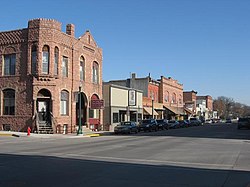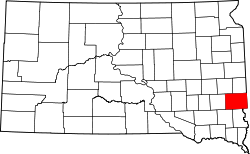2010 census
At the 2010 census there were 3,633 people, 1,388 households, and 973 families living in the city. The population density was 1,789.7 inhabitants per square mile (691.0/km2). There were 1,495 housing units at an average density of 736.5 per square mile (284.4/km2). The racial makeup of the city was 98.0% White, 0.1% African American, 0.6% Native American, 0.2% Asian, 0.2% from other races, and 0.9% from two or more races. Hispanic or Latino of any race were 1.4%. [13]
Of the 1,388 households 38.3% had children under the age of 18 living with them, 58.8% were married couples living together, 7.8% had a female householder with no husband present, 3.5% had a male householder with no wife present, and 29.9% were non-families. 25.1% of households were one person and 11.4% were one person aged 65 or older. The average household size was 2.58 and the average family size was 3.10.
The median age was 34.8 years. 28.9% of residents were under the age of 18; 6.6% were between the ages of 18 and 24; 27.6% were from 25 to 44; 21.7% were from 45 to 64; and 15% were 65 or older. The gender makeup of the city was 48.7% male and 51.3% female.
2000 census
At the 2000 census, there were 2,980 people, 1,127 households, and 793 families living in the city. The population density was 1,519.9 inhabitants per square mile (586.8/km2). There were 1,181 housing units at an average density of 602.3 per square mile (232.5/km2). The racial makeup of the city was 98.69% White, 0.13% African American, 0.47% Native American, 0.20% Asian, 0.07% from other races, and 0.44% from two or more races. Hispanic or Latino of any race were 0.64% of the population.
Of the 1,127 households 36.7% had children under the age of 18 living with them, 60.5% were married couples living together, 7.2% had a female householder with no husband present, and 29.6% were non-families. 26.0% of households were one person and 13.5% were one person aged 65 or older. The average household size was 2.55 and the average family size was 3.09.
The age distribution was 28.4% under the age of 18, 6.5% from 18 to 24, 27.3% from 25 to 44, 19.4% from 45 to 64, and 18.3% 65 or older. The median age was 36 years. For every 100 females, there were 91.4 males. For every 100 females age 18 and over, there were 90.3 males.
As of 2000 the median income for a household in the city was $42,572, and the median family income was $49,536. Males had a median income of $31,867 versus $24,333 for females. The per capita income for the city was $17,731. About 1.9% of families and 4.0% of the population were below the poverty line, including 2.3% of those under age 18 and 12.7% of those age 65 or over.


